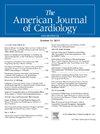经导管主动脉置换术后左心室肥大消退:自膨胀假体与球囊扩张假体的比较。
IF 2.3
3区 医学
Q2 CARDIAC & CARDIOVASCULAR SYSTEMS
引用次数: 0
摘要
关于假体与患者不匹配(PPM)对经导管主动脉瓣置换术(TAVR)后左室肥厚(LVH)消退的影响,目前报道有限。我们比较了环上自扩张(SE)和环内球囊扩张(BE)假体对 TAVR LVH 消退的相对影响。我们对 168 名连续 TAVR 患者的左心室质量指数(LVMi)回归情况进行了评估,其中包括 60 名接受 SE 瓣膜(Evolut 系列)治疗的患者和 108 名接受 BE 瓣膜(Sapien 3)治疗的患者。所有患者均在基线时通过超声心动图确定了 LVH,并在平均 707±528 天的随访时间内重复测量了 LVMi。SE患者更多是女性(68.3% vs 46.3%,P=0.007),除此之外,两组患者在基线人口统计学和STS风险评分方面没有差异。SE患者在TAVR术后的有效孔面积与体表面积指数(EOAi)更高(0.98±0.29 vs 0.86±0.25 cm²/m²,p=0.006),平均主动脉瓣梯度更低(9.9±6.5 vs 12.8±5.8 mmHg,p=0.003),中度/重度PPM患病率更低(33.3 vs 49.1%,p=0.049)。随访期间,SE 组和 BE 组的 LVMi 变化相似,LVMi 的绝对变化(19.2±26.8 vs. 21.9±31.7g/m2,p=0.578)和相对 LVMi 下降(14.0±19.5 vs. 16.2±24.2%,p=0.547)相似。中度/重度 PPM 的 SE/BE 合并患者与无 PPM 的患者相比,LVMi 回归也无差异。总之,尽管TAVR术后EOAi、平均主动脉瓣梯度和假体-患者不匹配存在差异,但接受环上SE和环内BE假体的患者在中期随访期间的LVH消退程度没有差异。本文章由计算机程序翻译,如有差异,请以英文原文为准。
Left Ventricular Hypertrophy Regression Following Transcatheter Aortic Replacement: A Comparison of Self-Expanding Versus Balloon-Expandable Prostheses
There are limited reports on the impact of prosthesis-patient mismatch (PPM) on the regression of left ventricular hypertrophy (LVH) after transcatheter aortic valve replacement (TAVR). We compared the relative effects of supra-annular, self-expanding (SE) versus intra-annular, balloon-expandable (BE) prostheses on TAVR LVH regression. Regression of left ventricular mass index (LVMi) was evaluated in 168 consecutive TAVR patients, including 60 treated with SE valves (Evolut series) and 108 treated with BE valves (Sapien 3). All patients had LVH determined at baseline by echocardiography and had repeat LVMi measurements at a mean follow-up time of 707 ± 528 days. SE patients were more likely female (68.3% vs 46.3%, p = 0.007), but otherwise, the 2 cohorts did not differ with respect to baseline demographics and Society of Thoracic Surgeons risk score. SE patients had a higher effective orifice area indexed to body surface area after TAVR (0.98 ± 0.29 vs 0.86 ± 0.25 cm²/m², p = 0.006), with lower mean aortic valve gradients (9.9 ± 6.5 vs 12.8 ± 5.8 mm Hg, p = 0.003) and a lower prevalence of moderate/severe PPM (33.3% vs 49.1%, p = 0.049). On follow-up, changes in LVMi were similar between the SE and BE groups, with similar absolute changes in LVMi (19.2 ± 26.8 vs 21.9 ± 31.7 g/m2, p = 0.578) and relative LVMi decrease (14.0 ± 19.5 vs 16.2% ± 24.2%, p = 0.547). No difference in LVMi regression was also noted comparing combined SE/BE patients with moderate/severe PPM versus those without PPM. In conclusion, despite differences in effective orifice area indexed to body surface area, mean aortic valve gradient, and PPM after TAVR, the degree of LVH regression during intermediate follow-up did not differ between patients receiving supra-annular SE and intra-annular BE prostheses.
求助全文
通过发布文献求助,成功后即可免费获取论文全文。
去求助
来源期刊

American Journal of Cardiology
医学-心血管系统
CiteScore
4.00
自引率
3.60%
发文量
698
审稿时长
33 days
期刊介绍:
Published 24 times a year, The American Journal of Cardiology® is an independent journal designed for cardiovascular disease specialists and internists with a subspecialty in cardiology throughout the world. AJC is an independent, scientific, peer-reviewed journal of original articles that focus on the practical, clinical approach to the diagnosis and treatment of cardiovascular disease. AJC has one of the fastest acceptance to publication times in Cardiology. Features report on systemic hypertension, methodology, drugs, pacing, arrhythmia, preventive cardiology, congestive heart failure, valvular heart disease, congenital heart disease, and cardiomyopathy. Also included are editorials, readers'' comments, and symposia.
 求助内容:
求助内容: 应助结果提醒方式:
应助结果提醒方式:


